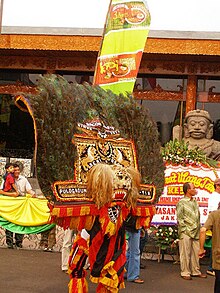Reog is a traditional Indonesian dance form. There are many types of Reogs in Indonesia, but the most notable ones are Reog Ponorogo (East Java) and Reog Sunda (West Java). Although both share a similar name, there is no connection nor similar theme among these traditions. Reog Ponorogo seems to be the kind of dance that demonstrate physical strength and extravagant lion-peafowl mask and costumes, while Reog Sunda is a lot more like a traditional musical comedy and dance.
Reog is a traditional dance that become the main identity for Ponorogo Regency. Reog National Festival is held every years along the anniversary of Ponorogo regency and Grebeg Suro celebration. Reog dance is also staged full moon nightly in paseban, Ponorogo town square. Reog told about the struggle for a prince who will propose to a beautiful princess. Reog Ponorogo tells the story of a mythical battle between the King of Ponorogo and the magical lion-like creature called Singa Barong. Singa Barong is a large mask usually made of tiger's or leopard's head skin, upon the mask attached a large fan adorned with peafowl feathers. The Singa Barong mask was notoriously heavy, the dancer of Singo Barong bear the mask about 30 – 40 kg weight and supported by the strength of their teeth.
The leading figures in Reog Ponorogo performance includes:
- Klono Sewandono, A men in regal attire wearing mask in proud and pompous dance, play the role as the King of Ponorogo
- Bujang Anom, rough youthful men wearing red mask, they performed acrobatic dances and sometimes also involved trance.
- Jatil, the youthful handsome horsemen riding horses made of weaved bamboo, similar to Kuda Lumping dance. Today Jatil usually performed by female dancers.
- Warok, played as Singa Barong, the mythical creature. The one that allowed to performed this mask dance is called warok. A warok is the hororary title of local hero or strongman of the village that possessed both exceptional spiritual and phyisical strength. The dance itself is demonstration of phyisical strength of the dancers.
Reog Ponorogo usually consists of three sets of dances; each dance is performed by several dancers:
- The first dance is the opening dance, performed by Bujang Anom, male dancers wearing black costumes. The costume describe rough men with intimidating moustache and other masculinity symbols.
- The second dance is the Jaran Kepang dance performed by Jatil; it is originally performed by a gemblak, a handsome and youthful teenage boy wearing colourful costumes. Today the female dancers were usually played this role.
- The third dance is the main attraction of the show; it is performed by all the Reog dancers. The warok as the main male dancer, wearing a large and heavy lion mask, dances in the centre of the stage while the other dancers dance around him. To demonstrate the warok's extraordinary strength Jatil or female dancers riding on top of lion mask and being carried around.
Culture and traditions of Reog Ponorogo
The dance describe Klono Sewandono the king of Ponorogo on his journey to Kediri to seek the hands of Princess Songgo Langit. On his journey he was attacked by a vicious monster called Singa Barong, a mythical lion with peacock on its head. Historians trace the origin of Reog Ponorogo as the satire on the incompetence of Majapahit rulers during the end of the empire. It describe the innate Ponorogo liberty and its opposition on centralist Majapahit rule. The lion represent the king of Majapahit while the peafowl represent the queen, it was suggested that the king was incompetent and always being controlled by his queen. The beautiful, youthful and almost effeminate horsemen describe the Majapahit cavalry that have lost their manliness.
Reog Sunda is very different than Ponorogo one, reog Sunda did not incorporate a large lion mask adorned with peafowl feathers like Reog Ponorogo, and did not incorporate trance state. The Reog Sunda performance combines comedy, joke, music, and funny comical movements and dances of the performers. The performers usually consist of four personnel, one called dalang directing the shows, similar to dalang in wayang performance, one called wakil or vice-dalang, the other two were the performers that interact and do the order of the dalang. Each performers carying and using musical instruments such as dogdog, beungbreung, gudubrag (types of traditional drums), and kecrek (similar to maraca) or tambourine, other instruments such as kendang, gong, kacapi might also used. The performance usually took one hour to one and half hour of music, dance and jokes, filled with social messages or religious wisdom.

3 comments:
=))
very nice
Leave a Reply